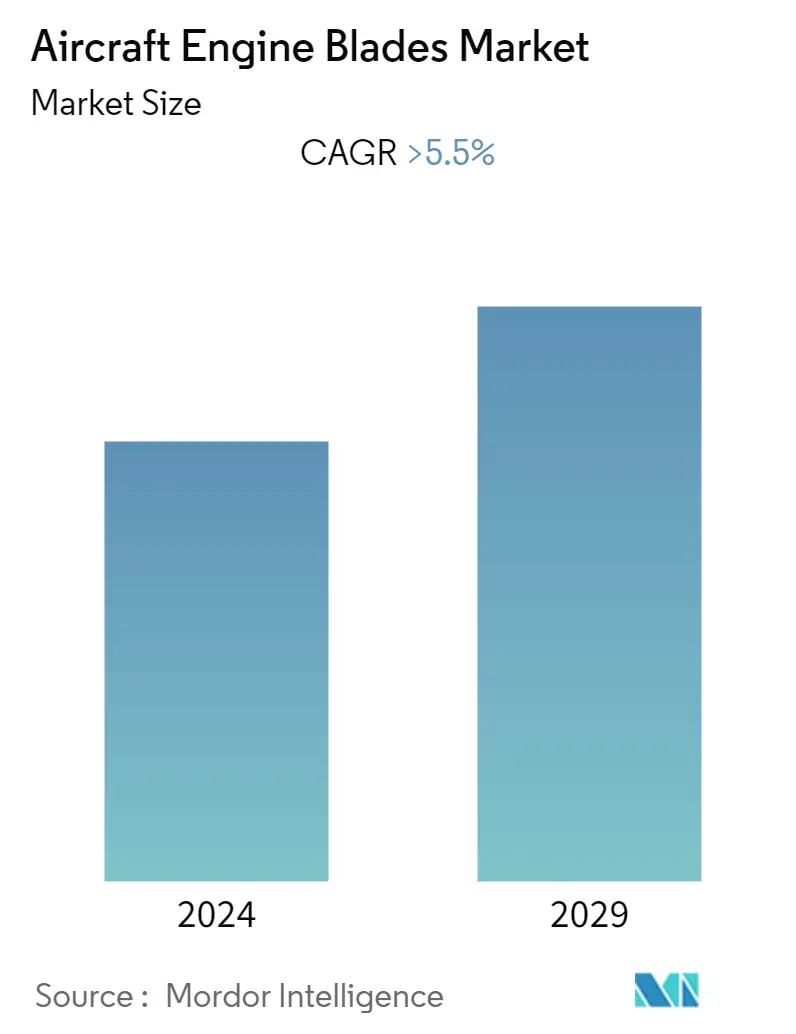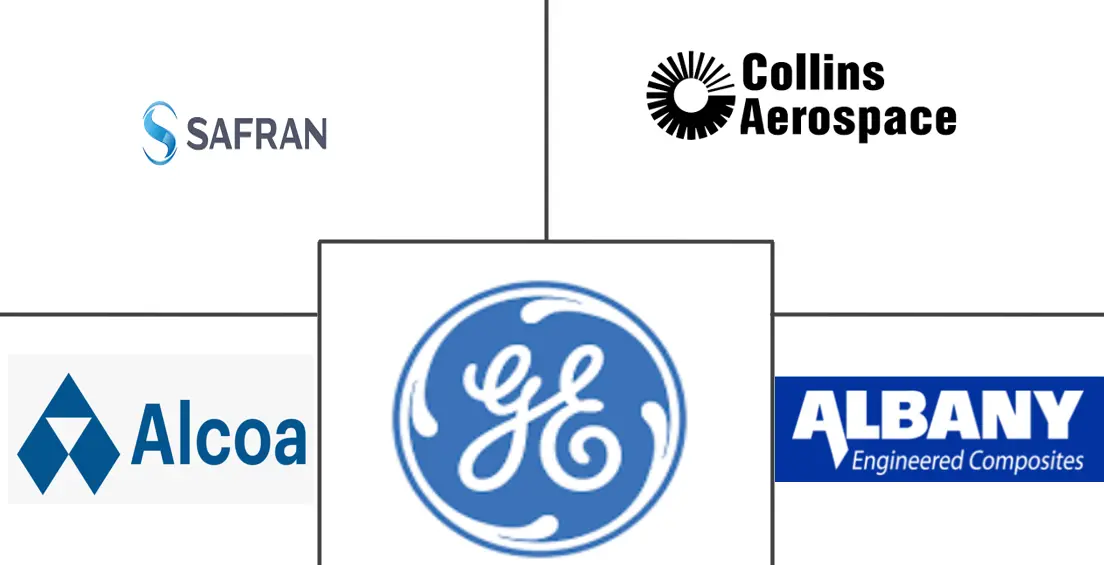Market Size of Aircraft Engine Blades Industry

| Study Period | 2019 - 2029 |
| Base Year For Estimation | 2023 |
| CAGR | 5.50 % |
| Fastest Growing Market | Asia Pacific |
| Largest Market | North America |
| Market Concentration | Medium |
Major Players
*Disclaimer: Major Players sorted in no particular order |
Aircraft Engine Blades Market Analysis
The aircraft engine blades market is anticipated to register a CAGR of over 5.5% during the forecast period.
- The COVID-19 pandemic significantly impacted aircraft suppliers worldwide, impairing several aspects of the value chain, such as a dip in demand, financial exposure, worker impairment, and supply disruptions. Some of these disruptions are still persistent in the sector, which has limited the growth of the aircraft engine blades market to a certain extent. The commercial aviation sector has partially recovered from the setback driven by growth in fleet size due to passenger traffic growth. Since the military aviation sector was minimally affected due to the pandemic, considering the deployment of turbine engine blades in military aircraft, the considerable rise in military spending may boost industry recovery.
- The demand for engines and other aviation-related components has expanded dramatically, creating demand-side pressure on the engine OEMs and compelling them to expand their manufacturing capabilities to cater to the growing demand. New aviation emission norms are also encouraging operators to opt for a modern low-emission engine for their fleet to ensure compliance with the emerging emission standards across the globe. The new-generation engines require extensive R&D, thereby driving the resources invested toward developing and producing new-generation engines for modern aircraft models.
Aircraft Engine Blades Industry Segmentation
The aircraft engine blades consist of vanes and valves used in aircraft. These vanes and valves may produce a smooth gas flow by directing and compressing the air inside the engine. A turbine blade, an aerodynamic blade positioned on the rim of a turbine disc with multiple blades, generates a tangential force that rotates a turbine rotor. Both steam turbines and gas turbine engines use these blades. The gas produced by the combustor, which has an elevated temperature and pressure, is used by the blades to generate energy. The engine's blades are typically its limiting element.
The aircraft engine blade market is segmented by blade type, application, material type, and geography. By blade type, the market is segmented into compressor blades, turbine blades, and fan blades. By application, the market is divided into commercial, military, and general aviation. By material, the market is segmented into titanium, nickel alloy, composites, and other materials. By geography, the market is segmented into North America, Europe, Asia Pacific, Latin America, and the Middle East and Africa.
The market sizing and forecasts have been provided in value (USD million) for all the above segments.
| Blade Type | |
| Compressor Blades | |
| Turbine Blades | |
| Fan Blades |
| Application | |
| Commercial | |
| Military | |
| General Aviation |
| Material | |
| Titanium | |
| Nickel Alloy | |
| Composites | |
| Other Materials |
| Geography | |||||||
| |||||||
| |||||||
| |||||||
| |||||||
|
Aircraft Engine Blades Market Size Summary
The aircraft engine blades market is poised for growth, driven by a recovery in the commercial aviation sector and increased military spending. The pandemic had a significant impact on the industry, causing disruptions in demand and supply chains, but the sector is gradually rebounding. The commercial aviation market is seeing a rise in fleet size due to growing passenger traffic, while the military aviation sector remains robust. This recovery is further supported by the demand for new-generation engines that comply with emerging aviation emission norms, prompting original equipment manufacturers (OEMs) to expand their manufacturing capabilities. The market is characterized by a moderate level of consolidation, with key players like Safran SA, General Electric Company, and Raytheon Technologies Corporation focusing on developing efficient and lightweight engine blades.
The Asia-Pacific region is emerging as a significant growth area, with increasing air travel demand prompting fleet expansions by airlines. This has led to a surge in orders for new aircraft and engine blades, as airlines seek to modernize their fleets. The region's status as a maintenance, repairs, and operations hub is further bolstered by projections of rising military expenditure and a growing general aviation fleet. Prominent market players are investing in research and development to innovate new-generation engines and composite aircraft engine blades, creating opportunities for growth. Collaborations and strategic acquisitions are also shaping the market, as companies seek to enhance production capabilities and adopt advanced manufacturing technologies.
Aircraft Engine Blades Market Size - Table of Contents
-
1. MARKET DYNAMICS
-
1.1 Market Overview
-
1.2 Market Drivers
-
1.3 Market Restraints
-
1.4 Porter's Five Forces Analysis
-
1.4.1 Bargaining Power of Buyers/Consumers
-
1.4.2 Bargaining Power of Suppliers
-
1.4.3 Threat of New Entrants
-
1.4.4 Threat of Substitute Products
-
1.4.5 Intensity of Competitive Rivalry
-
-
-
2. MARKET SEGMENTATION
-
2.1 Blade Type
-
2.1.1 Compressor Blades
-
2.1.2 Turbine Blades
-
2.1.3 Fan Blades
-
-
2.2 Application
-
2.2.1 Commercial
-
2.2.2 Military
-
2.2.3 General Aviation
-
-
2.3 Material
-
2.3.1 Titanium
-
2.3.2 Nickel Alloy
-
2.3.3 Composites
-
2.3.4 Other Materials
-
-
2.4 Geography
-
2.4.1 North America
-
2.4.1.1 United States
-
2.4.1.2 Canada
-
-
2.4.2 Europe
-
2.4.2.1 United Kingdom
-
2.4.2.2 France
-
2.4.2.3 Germany
-
2.4.2.4 Rest of Europe
-
-
2.4.3 Asia-Pacific
-
2.4.3.1 China
-
2.4.3.2 Japan
-
2.4.3.3 India
-
2.4.3.4 South Korea
-
2.4.3.5 Rest of Asia-Pacific
-
-
2.4.4 Latin America
-
2.4.4.1 Brazil
-
2.4.4.2 Mexico
-
2.4.4.3 Rest of Latin America
-
-
2.4.5 Middle-East and Africa
-
2.4.5.1 United Arab Emirates
-
2.4.5.2 Saudi Arabia
-
2.4.5.3 South Africa
-
2.4.5.4 Rest of Middle-East and Africa
-
-
-
Aircraft Engine Blades Market Size FAQs
What is the current Aircraft Engine Blades Market size?
The Aircraft Engine Blades Market is projected to register a CAGR of greater than 5.5% during the forecast period (2024-2029)
Who are the key players in Aircraft Engine Blades Market?
General Electric Company, Safran SA, Raytheon Technologies Corporation, Albany International Corp. and Alcoa Corporation are the major companies operating in the Aircraft Engine Blades Market.

